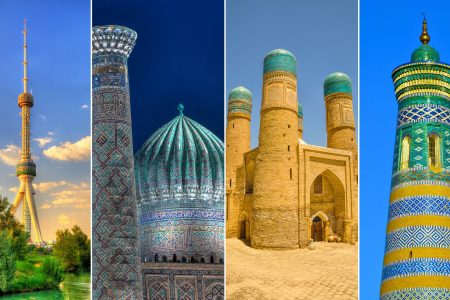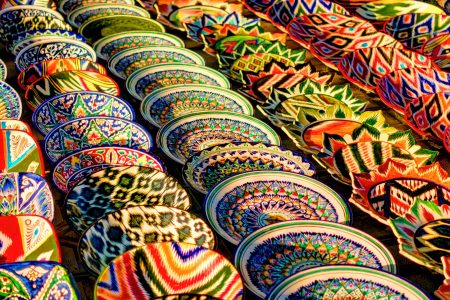The fabulous city of Khiva, the city of “Thousand and One Nights”, has surprised local and foreign tourists for centuries with its unique beauty and charm. Whenever you visit this city and stroll through its ancient streets and surrounding historic buildings, you feel like you are back to the bygone days. An “open-air museum” status was given to Khiva as it is one of the few cities in the world where an entire open-air city has been preserved in the form of old historical landmarks as a result Khiva turned to one of the most popular international touristic destinations. In addition to that more than 122 archaeological iconic statues and architectural landmarks related to the 6th to the 5th centuries BC till the beginning of the 20th century have been preserved in the old city and protected by Government. In its monuments, the most beautiful works of folk artists of the Khorezm oasis can be observed * (Khiva is part of the Khorezm region). In particular, Ichan-Kal`a (Internal castle) part of Khiva is the only preserved old city in the Central Asia, its fate in the past, its architectural monuments are closely connected with the historical and cultural development of Khorezm oasis.
Khiva is ancient open museum city as well as it is considered residential area, just like Rome, Granada and some other historical cities. Consequently, it influence positively to the local and foreign tourists by letting them to observe alive old city with the huge interest. One of the oldest museums in Uzbekistan- Khiva “Ichan-Kala” State Historical-Architectural Museum-Reserve area is 26 hectors and it was wrapped with ancient walls of “Ichan-Kala”.
Khiva is the first city in Central Asia to be included in the World Heritage List by a special resolution of the 14th session of UNESCO in Canada on December 12, 1990. Archaeological researchers said that the city is over 2,500 years old. Herodotus, known as “the father of history”, also mentioned some information about Khorezm and Khorezmians in his novels.
In the middle Ages, Khiva was a city of scientists and scholars. There had been carried out numerous experiments and discoveries for the development of astronomy, mathematics, and medicine by great scientists Abu Raikhan Beruni, Abu Ali ibn Sino (Avisenna) in the large centers of science. Mamun Academy was established and researches were carried out by the greatest oriental scientists and scholars during the timeline of King Mamun ibn Muhammad. Famous poets of the 19th century Shermuhammad Munis and Ogahi created their novels in this city. It is also vital to mention that there is another great scientist, who grew up in Khorezm region, and the science he founded has played a huge role in the development of humankind. This scientist was the famous Abu Abdullah Muhammad ibn Musa al-Khwarizmi, who founded the science of algebra, and this term is well known from his book “A Brief Book on Algebraic Calculus”. Apparently, the word “ algebraic ” comes from the word of “algebra” and every one knows about it.
During its flourished time, Khorezm was the largest center of international trade and a key part of the Great Silk Road. Merchants from the Volga region, India, Iran came to this city and traveled to the Middle East, East Turkestan and China by caravans. Various trade routes from Khiva led to Mongolia, through the steppes of Kazakhstan to Saksin, a trading city on the Volga, and from there to the Russian principalities and Europe.
Indeed, Khorezm region, especially the city of Khiva is considered a unique and holly place in Turkish world. In 2019 on November 30, at the 37th meeting of the Permanent Council of the International Organization of Turkish Culture – TURKSOY, Khiva was declared the cultural capital of Turkish world in 2020.



